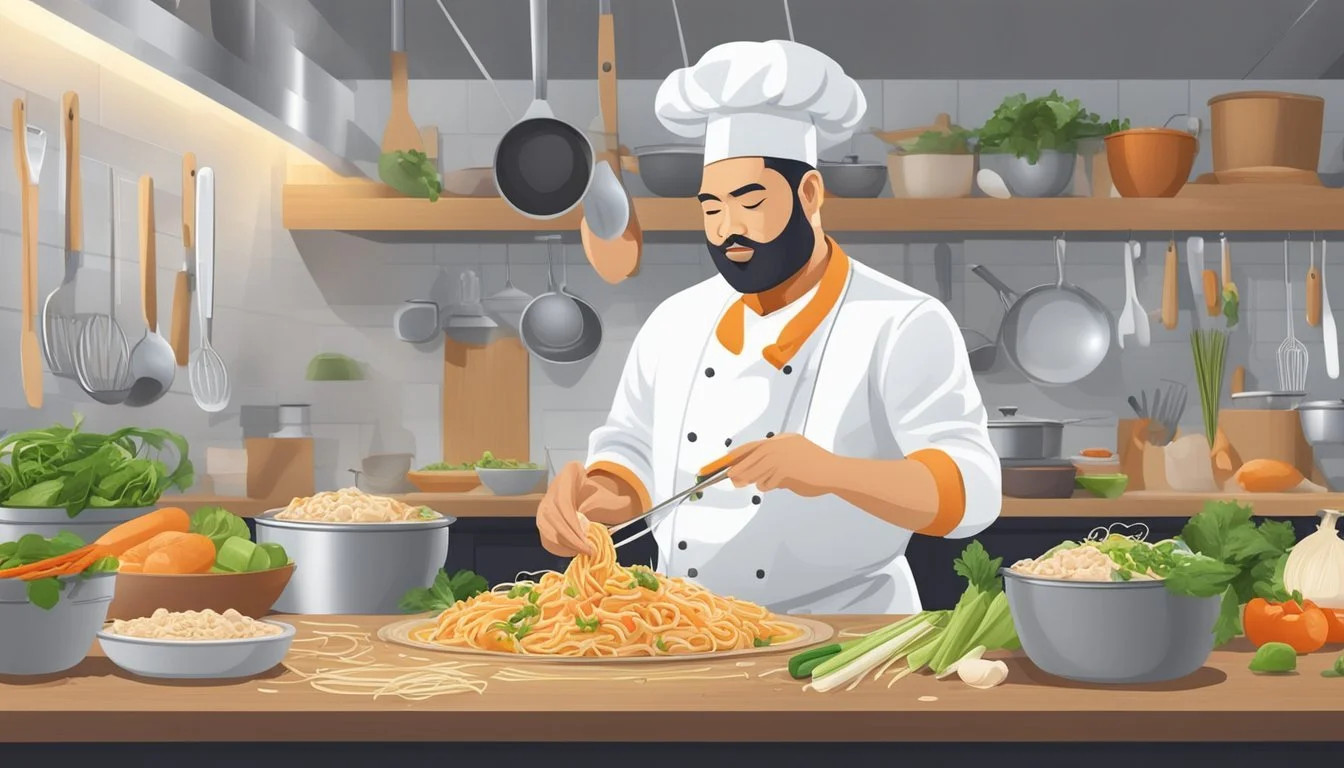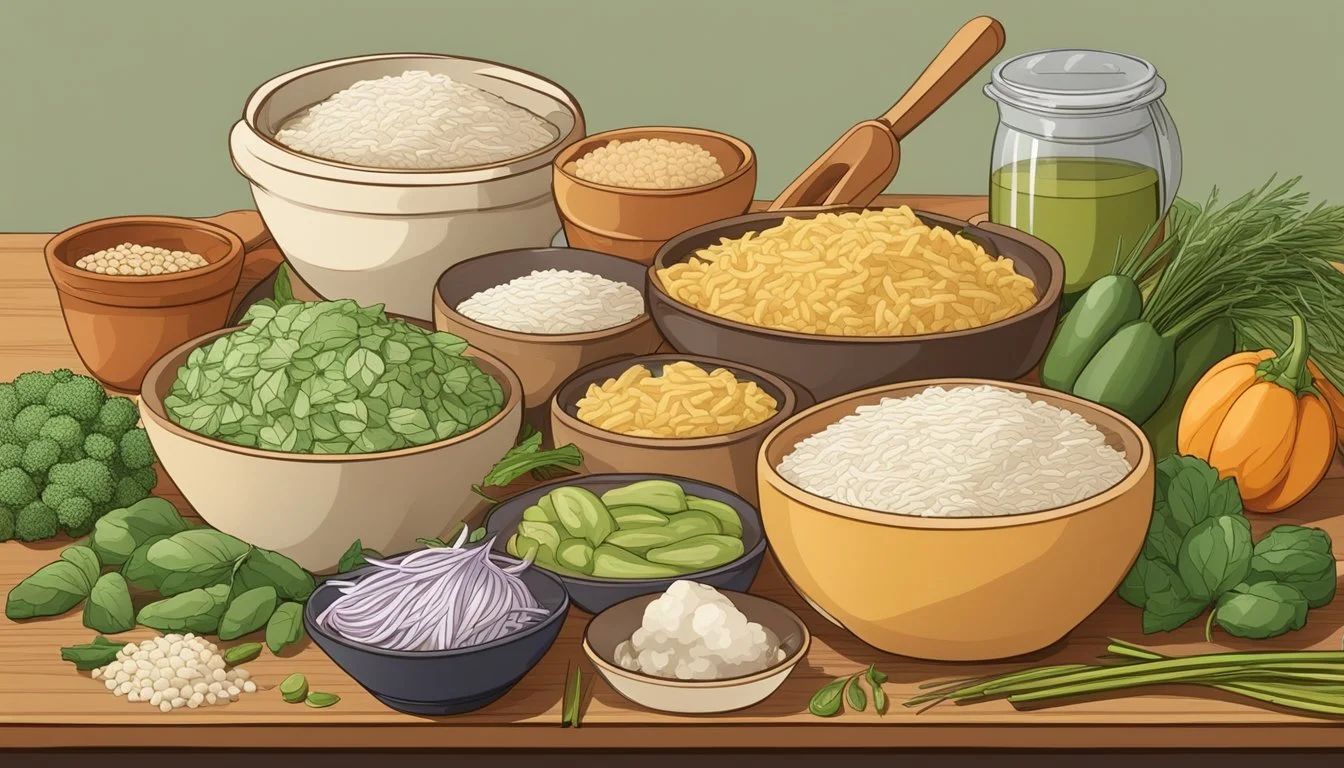How Long Does Gluten-Free Chicken Pad Thai Last?
Storage Tips & Shelf Life
When it comes to enjoying your gluten-free chicken pad thai, knowing how long it lasts is crucial for maintaining both flavor and safety. Properly stored in an airtight container in the refrigerator, gluten-free chicken pad thai can last for up to 3-4 days. This ensures that each bite remains fresh and delicious without compromising on quality.
The key to extending the shelf life of your dish lies in careful storage practices. Refrigeration helps preserve the ingredients' integrity, especially the chicken and vegetables. Additionally, when reheating, make sure to do so thoroughly to enjoy the same burst of flavors and delightful texture as when it was first cooked.
For those planning meals ahead or considering batch cooking, this dish offers the convenience of being a quick and easy option that doesn't skimp on taste. Just remember, consuming it within the recommended timeframe will guarantee the best gastronomic experience.
Understanding Gluten-Free Pad Thai
Gluten-Free Pad Thai is a popular dish known for its rich flavors and nutritional benefits. It's essential to explore the components of Pad Thai and the significance of using gluten-free ingredients in its preparation.
Components of Pad Thai
Pad Thai primarily consists of rice noodles, which are naturally gluten-free. The dish includes vegetables like bell peppers and carrots, which add color and texture.
A traditional Pad Thai sauce often contains a blend of tamarind paste, fish sauce, and palm sugar. For a gluten-free version, ingredients like gluten-free soy sauce, tamari, or coconut aminos can be used to replace regular soy sauce.
Protein options include chicken, shrimp, or tofu. Eggs are also a standard ingredient that contributes to the dish's texture.
Significance of Gluten-Free Ingredients
Using gluten-free ingredients in Pad Thai is crucial for those with celiac disease or gluten sensitivity. Gluten-free soy sauce, tamari, and coconut aminos help in maintaining the dish's authenticity without compromising dietary restrictions.
Gluten-free fish sauce ensures that the savory umami flavor is preserved.
By using gluten-free alternatives, one can enjoy the health benefits and rich taste of Pad Thai without adverse reactions. Additionally, preparing a gluten-free version promotes inclusivity, allowing more people to enjoy this beloved dish.
Essential Ingredients for Chicken Pad Thai
A perfect Chicken Pad Thai hinges on the freshness and quality of its ingredients. Ensuring high-quality chicken, a variety of vegetables and herbs, and the right flavor enhancers is key to creating a delicious dish.
Selecting Quality Chicken
High-quality chicken is fundamental to any Chicken Pad Thai recipe. Choose boneless, skinless chicken breasts or thighs for best results. Thighs offer richer flavor and juiciness, while breasts provide a leaner option.
When selecting chicken, look for:
Freshness: The meat should be firm and pinkish without any unpleasant odor.
Organic: If possible, opt for organic or free-range chicken, which often has a better taste and texture.
Prepare the chicken by cutting it into thin strips or bite-sized pieces to ensure even cooking and better integration with the noodles and vegetables.
Variety of Vegetables and Herbs
A colorful array of vegetables and herbs enhances the flavor and nutritional value of Chicken Pad Thai. Key vegetables include:
Bean sprouts: Add crunch and a fresh, slightly sweet flavor.
Julienned carrots and bell peppers: Provide sweetness and vibrant color.
Green onions: Offer a mild onion flavor and freshness.
Essential herbs:
Cilantro: Adds a bold, fresh taste. Chop the leaves and add them just before serving.
Garlic: Imparts a rich, savory element to the dish. Finely mince and sauté until fragrant.
Optimal Flavor Enhancers
The flavor profile of Chicken Pad Thai hinges on the right combination of sauces and seasonings. Crucial components include:
Fish sauce: Adds umami depth.
Gluten-free tamari or soy sauce: Contributes a salty, savory dimension.
Lime juice: Provides acidity and brightness.
Additional flavor boosters:
Peanuts: Roasted and chopped, they add crunchy texture and a nutty flavor.
Eggs: Lightly scrambled and mixed in, they offer richness.
Red pepper flakes or sriracha: For those who enjoy a bit of heat.
Together, these ingredients ensure your Chicken Pad Thai is bursting with layered, complex flavors making each bite a delightful experience.
Preparing Gluten-Free Chicken Pad Thai
When preparing gluten-free chicken pad Thai, it's important to follow a precise recipe and use appropriate cooking techniques. Here are the key steps and tips to create a delicious and healthy dish.
Mastering the Pad Thai Recipe
To start, gather all necessary ingredients. You will need gluten-free rice noodles, chicken breast, bell peppers, carrots, green onions, garlic, and a blend of sauces. It's essential to prepare these ingredients before cooking to ensure a smooth process.
Begin by chopping the vegetables and chicken. Cook the chicken in a pan with a bit of olive oil over medium heat until it's fully cooked and tender.
For the pad Thai sauce, combine brown sugar, soy sauce, and fish sauce in a small bowl. This mix will provide the dish's signature flavors.
Cook the rice noodles according to the package instructions, then set them aside while you sauté the vegetables in the same pan used for the chicken. Once the vegetables are tender and fragrant, add the noodles, chicken, and sauce. Toss everything together thoroughly to combine the flavors.
Cooking Techniques and Tips
When cooking gluten-free chicken pad Thai, pay attention to the sequence and method. Preheat your stove to medium heat and ensure your pan is hot before adding ingredients. This helps in achieving even cooking.
Use a large pan or wok for better results. This allows ample space for stirring and ensures the ingredients cook evenly. When sautéing garlic and vegetables, keep the heat at medium to avoid burning, which can make the dish bitter.
Stir-frying requires quick, consistent movement to prevent sticking and ensure even cooking. When the vegetables are almost tender, add cooked chicken and noodles. Add the sauce mixture last. This helps to avoid overcooking and retains the vibrant flavors and textures.
For best results, serve the dish immediately while it's hot. Garnish with chopped green onions and a squeeze of lime for extra freshness.
These specific steps and tips will help you prepare a flavorful and authentic gluten-free chicken pad Thai.
Proper Storage and Shelf Life
To maintain freshness and safety, storing gluten-free chicken pad Thai properly in the refrigerator is crucial. Proper handling can extend the dish's shelf life and ensure it remains safe for consumption.
Storing Leftover Pad Thai
After preparing gluten-free chicken pad Thai, promptly store any leftovers in an airtight container. This helps prevent contamination and keeps the dish fresh longer. Store the container in the refrigerator at a temperature below 40°F (4°C).
Leftover chicken pad Thai typically lasts 3 to 4 days in the fridge. When serving leftovers, ensure it is reheated to an internal temperature of 165°F (74°C) to kill any harmful bacteria. For individuals with celiac disease, it's essential to avoid cross-contamination by using clean utensils and surfaces.
Extending Freshness and Safety
For meal prep enthusiasts, consider preparing and storing portions in separate containers. This way, each serving maintains its integrity and flavor. Properly sealed containers are key to preserving the dish's moisture and taste.
Reheating leftover pad Thai correctly is vital for maintaining its quality. Use a microwave-safe dish with a cover, or reheat on the stovetop, stirring occasionally. Ensure the dish reaches a steaming hot temperature throughout. Keeping leftovers in the fridge promptly and reheating safely supports a tasty and safe meal while preventing foodborne illnesses.
Nutritional Information and Dietary Considerations
This gluten-free Chicken Pad Thai is packed with proteins, carbs, and essential nutrients. It can be adapted to fit various dietary needs, including vegan, vegetarian, and dairy-free options.
Health Benefits and Highlights
Gluten-free Chicken Pad Thai offers a balanced macronutrient profile. A single serving provides approximately 490 calories. The protein content is significant, making up 39% of the calories. This high protein content helps in muscle repair and growth, making it ideal for physically active individuals.
The dish also includes essential vitamins and minerals found in vegetables like bell peppers and carrots. These vegetables are rich in vitamins A and C, promoting healthy vision and immune function. Additionally, the fiber in vegetables supports digestive health.
Adapting the Recipe for Special Diets
To make this dish vegan or vegetarian, replace chicken with tofu or tempeh. Both options are protein-rich and maintain the dish's nutritional integrity. For a dairy-free version, ensure all ingredients, including sauces, do not contain dairy.
Soy sauce is commonly used in Pad Thai, but it can be high in sodium. Opt for low-sodium soy sauce to reduce sodium intake. For those with soy allergies, coconut aminos serve as an excellent alternative. This helps to maintain the dish's savory flavor without compromising dietary restrictions.
Using these adaptations, Chicken Pad Thai can be customized to fit a variety of dietary preferences and requirements.
Culinary Variations and Ideas
When making gluten-free chicken pad thai, numerous alternative ingredients and creative serving suggestions can be explored to enhance flavor and cater to dietary preferences. Experimenting with different proteins, noodles, and garnishes can provide a unique twist to this classic Thai dish.
Alternative Ingredients and Substitutions
Using different proteins such as tofu or shrimp can offer a flavorful and authentic taste. Chicken thighs may be used instead of chicken breasts for a juicier texture. For those looking for a lighter version, zucchini noodles are an excellent substitute for flat rice noodles.
In terms of sauce, tamarind paste creates a more authentic, tangy flavor. Peanut butter can add a rich and creamy note, while avocado oil offers a healthier alternative to traditional vegetable oil. Sweetening with brown sugar aligns well with classic Thai recipes, but other sweeteners like honey can also be used.
Creative Serving Suggestions
Serving gluten-free chicken pad thai with a variety of garnishes can elevate its presentation and taste. Crushed peanuts or chopped peanuts add a crunchy texture. A sprinkling of red pepper flakes enhances the dish's spiciness, whereas adding shredded carrots and shallots provides additional freshness and color.
Offering a side of stir-fried vegetables such as bell peppers and garlic can complement the main dish nicely. For a vibrant presentation, arrange the noodles on a large platter and sprinkle with fresh lime juice and chopped cilantro. This style makes the dish visually appealing and suitable for gatherings and social events.
Enjoying the dish warm ensures the flavors meld perfectly, maintaining the integrity and texture of the ingredients.
Final Thoughts
Gluten-free chicken pad thai can be a delicious and convenient meal. It's important to store it properly and understand how long it can last to ensure its taste and safety.
Summarizing Key Points
To maximize the shelf life of gluten-free chicken pad thai, refrigerate it in airtight containers. Typically, it lasts for 3 to 4 days when stored at a consistent temperature of 40°F (4°C). Freezing the dish extends its shelf life to about 1-2 months, with minimal impact on flavor and texture.
When reheating, make sure the pad thai reaches an internal temperature of 165°F (73.9°C) to eliminate any bacteria that might have developed. Avoid leaving the pad thai at room temperature for more than two hours to prevent spoilage.









